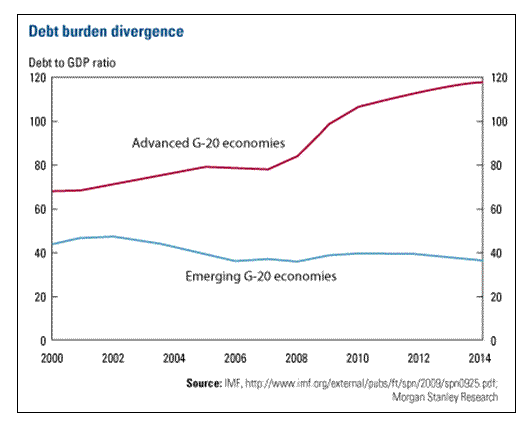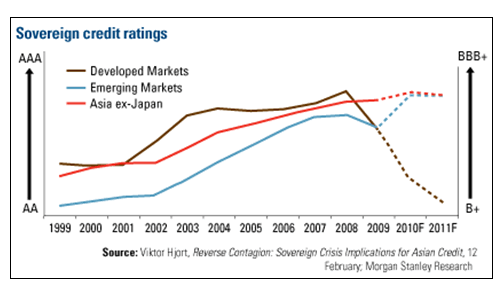Sovereign Debt Credit Ratings Emerging Markets Advantage
Economics / Emerging Markets Mar 17, 2010 - 08:10 AM GMTBy: Frank_Holmes
 It’s not a good time to be a developed economy.
It’s not a good time to be a developed economy.
Sovereign debt is at or near the crisis point in Greece, Spain, Ireland and Portugal. It’s also a big issue and getting bigger in the United States, Britain, Japan and a number of other countries.
Mohamed El-Erian, CEO at bond giant Pimco, was right when he wrote in Thursday’s Financial Times that sovereign debt represents “a significant regime shift in advanced economies with consequential and long-lasting effects.”
Debt conditions are much better in the major emerging markets, as you can see in the chart below. In the G-20 largest developed economies, sovereign debt burdens are now at about 100 percent of GDP, while in the 20 most important emerging markets, debt represents only about 40 percent of GDP.

In the next few years, the forecast sees the G-20 ratio rising another 20 percent. In the U.S., the ratio is already at its highest level since World War II, and another $10 trillion (70 percent of current GDP) will be added over the next decade. Meanwhile, the emerging 20’s sovereign debt-to-GDP actually goes down as a result of smaller budget deficits.
The lighter debt load benefits emerging markets in a number of ways, particularly in how risks are measured and perceived.
Sovereign credit ratings for emerging markets are improving, while the credit ratings of developed markets are dropping off significantly. This can be seen in the chart below – of course, developed markets still have higher ratings (left axis versus right axis) but the trend is for the key emerging markets is notably upward.

Higher credit ratings mean lower costs of capital for these countries, which is a positive for economic growth in countries that are already growing faster than the developed markets.
Now what about equity prices? Historically, there has been a negative correlation between bond prices and equity prices in developed markets, in what can be viewed as a safety trade. In emerging markets, however, we see a positive correlation between bond prices and equity prices in recent years. This makes sense to us, because both of these asset classes are driven by money flows from investors attracted by improving economic prospects in emerging countries.
Emerging markets have had appeal for risk-tolerant investors because these economies are growing faster and their companies have generated higher returns. The sovereign debt issue is reducing the relative risk of investing in both bonds and equities in these dynamic markets – in this scenario, investors should consider the equities to capture the higher return.
Follow U.S. Global Investors on Twitter ;@USFUNDS. Become our fan on Facebook.
By Frank Holmes, CEO , U.S. Global Investors
Frank Holmes is CEO and chief investment officer at U.S. Global Investors , a Texas-based investment adviser that specializes in natural resources, emerging markets and global infrastructure. The company's 13 mutual funds include the Global Resources Fund (PSPFX) , Gold and Precious Metals Fund (USERX) and Global MegaTrends Fund (MEGAX) .
More timely commentary from Frank Holmes is available in his investment blog, “Frank Talk”: www.usfunds.com/franktalk .
Please consider carefully the fund's investment objectives, risks, charges and expenses. For this and other important information, obtain a fund prospectus by visiting www.usfunds.com or by calling 1-800-US-FUNDS (1-800-873-8637). Read it carefully before investing. Distributed by U.S. Global Brokerage, Inc.
All opinions expressed and data provided are subject to change without notice. Some of these opinions may not be appropriate to every investor. Gold funds may be susceptible to adverse economic, political or regulatory developments due to concentrating in a single theme. The price of gold is subject to substantial price fluctuations over short periods of time and may be affected by unpredicted international monetary and political policies. We suggest investing no more than 5% to 10% of your portfolio in gold or gold stocks. The following securities mentioned in the article were held by one or more of U.S. Global Investors family of funds as of 12-31-07 : streetTRACKS Gold Trust.
Frank Holmes Archive |
© 2005-2022 http://www.MarketOracle.co.uk - The Market Oracle is a FREE Daily Financial Markets Analysis & Forecasting online publication.



